We replace the working fluid in the hydraulic drive of the brake system in accordance with the maintenance schedule - every 30 thousand kilometers or after two years (whichever comes first).
The reserve of hydraulic brake fluid is located in the reservoir located on the main brake cylinder.
A sensor is installed to control the level of the working fluid in the tank.
When the fluid level drops below the permissible level, the parking brake and brake system malfunction indicator lights up in the instrument cluster.
If there is no fluid leakage in the hydraulic drive, then the fluid level in the reservoir decreases due to an increase in the volume of the hydraulic system.
The volume increases when the pistons are extended from the working cylinders of the front (and to a lesser extent the rear) wheels with a decrease in the thickness of the lining of the brake pads as a result of lining wear.
Even if there is a sensor, we recommend that you periodically visually check the fluid level in the tank, since during the operation of the car a malfunction may occur, both of the fluid level sensor itself, and of the signaling device located in the instrument cluster, or their electrical circuits.
To check the fluid level, we install the car on a flat horizontal platform.
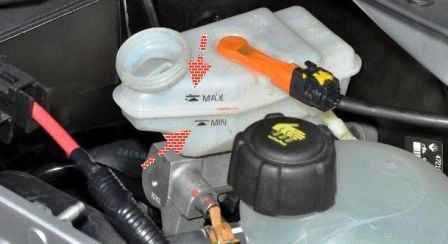
The MIN and MAX marks are made on the tank, between which the working fluid level should be.
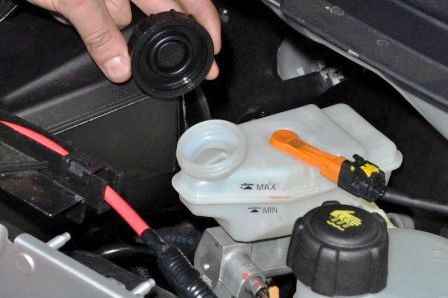
To add working fluid to the reservoir, unscrew and remove the reservoir cap

Add fluid to the tank up to the MAX mark.
Tighten the tank cap.
If the level of the working fluid in the tank is constantly decreasing, then there is most likely a leak in the system.
In this case, it is necessary to check the tightness of the brake and clutch hydraulic drives and eliminate the malfunction.
Brake fluid change
We perform work on a viewing ditch or overpass.

We pump out the old fluid from the reservoir with a rubber bulb or syringe and fill the reservoir with new working fluid.
We bleed the hydraulic drive of the brake system until the new fluid (lighter than the old one) begins to come out of the bleeders of all working cylinders.
After bleeding the hydraulic drive of the brake system, we bring the fluid level in the reservoir to normal.
Bleeding the brakes
We pump the brakes to remove air from the hydraulic drive after it is depressurized when replacing the master cylinder, working cylinders of the brake mechanisms of the wheels, the ABS unit, hoses, tubes, as well as in case of replacing the working fluid or when the brake pedal becomes “soft”.
We perform work on a viewing ditch or overpass.
We remove air from the system with the engine off, first from one circuit, and then from another in the following sequence:
- - brake mechanism of the right rear wheel;
- - brake mechanism of the left front wheel;
- - brake mechanism of the left rear wheel;
- - the brake mechanism of the right front wheel.
If air gets into one of the circuits, it is enough to bleed only this circuit, and not the entire hydraulic drive.
Before pumping, we check the level of the working fluid in the reservoir of the hydraulic drive of the brake system and, if necessary, add fluid
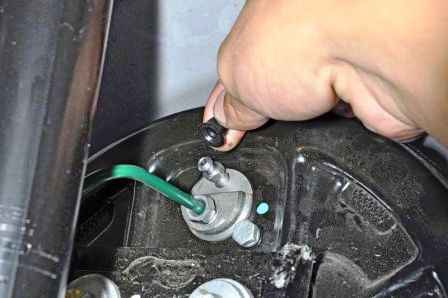
We clean the right rear wheel brake bleeder from dirt and remove the protective cap from it.
Loosen the bleeder valve with a ring wrench or an “8” head.
We put a transparent hose on the fitting, and immerse its free end in a container partially filled with working fluid.
The assistant should vigorously press the brake pedal to the stop 4-5 times and keep it pressed.
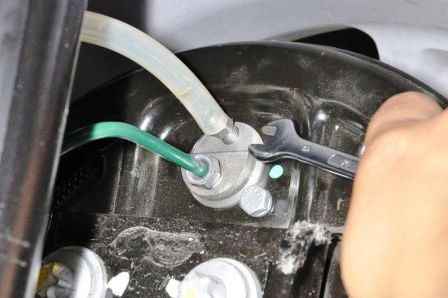
With a key of 8, we turn off the bleeder valve by ½ - ¾ turn.
In this case, liquid with air bubbles will flow out of the hose, and the brake pedal will go forward.
As soon as the liquid stops flowing out of the hose (while the pedal should reach the stop), we wrap the fitting, and only after that the assistant can release the pedal.
Repeat pumping until no air bubbles appear in the liquid coming out of the hose.
Remove the hose, wipe the bleeder dry and put a protective cap on it.
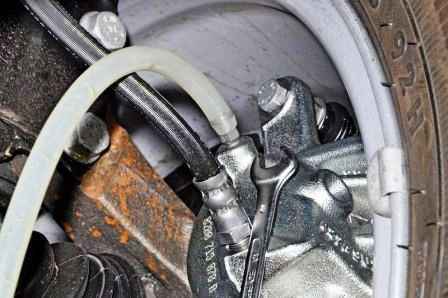
We pump the brake mechanism of the left front wheel as described above.
We also pump the brake mechanisms of another circuit.
When pumping, you need to monitor the fluid level in the tank and add fluid if necessary.
If you feel softness and increased travel when you press the brake pedal, then there is air left in the system.
In this case, we repeat pumping until the pedal becomes "hard", i.e. when pressed, go no more than half the distance to the floor.
If the air cannot be removed, we check the tightness of the connections, pipelines, hoses, main and working cylinders.
We tighten the leaking connections, we replace the faulty main and working cylinders.





